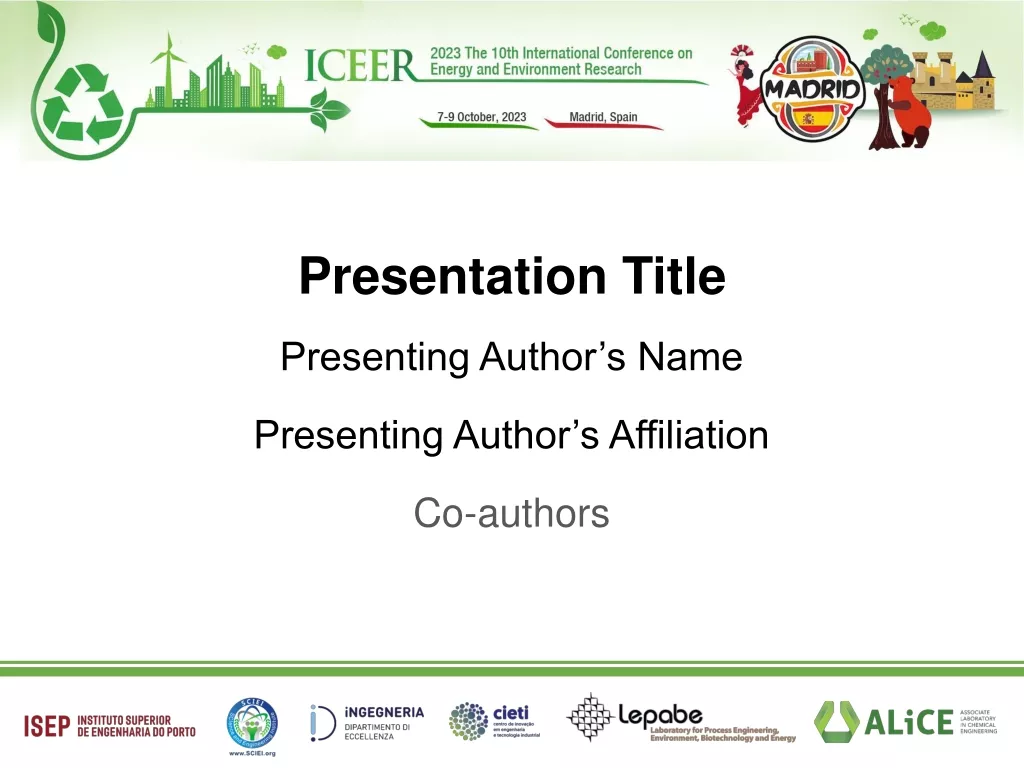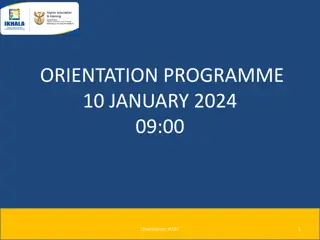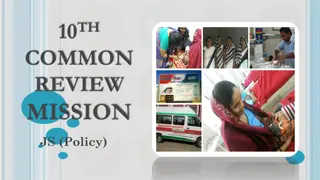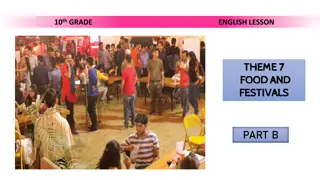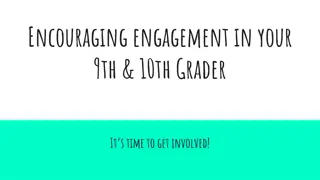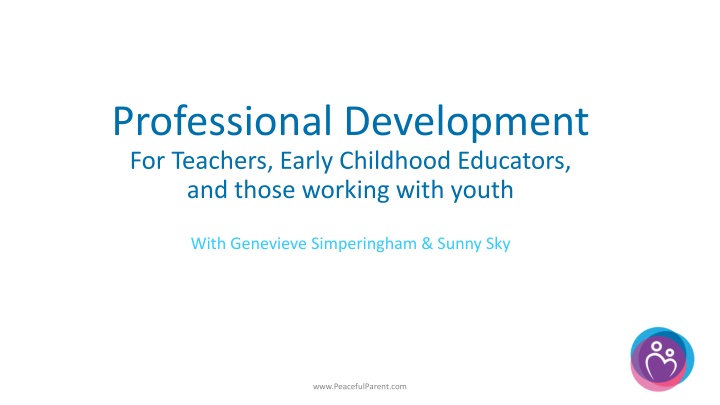
Positive Guidance Strategies for Educators and Youth Workers
Explore effective techniques for democratic discipline and behavior management, emphasizing needs-based approaches to promote a positive learning environment. Learn to address hyperarousal responses and dissociation in children while enhancing your ability to handle challenging situations mindfully and with empathy.
Uploaded on | 3 Views
Download Presentation

Please find below an Image/Link to download the presentation.
The content on the website is provided AS IS for your information and personal use only. It may not be sold, licensed, or shared on other websites without obtaining consent from the author. If you encounter any issues during the download, it is possible that the publisher has removed the file from their server.
You are allowed to download the files provided on this website for personal or commercial use, subject to the condition that they are used lawfully. All files are the property of their respective owners.
The content on the website is provided AS IS for your information and personal use only. It may not be sold, licensed, or shared on other websites without obtaining consent from the author.
E N D
Presentation Transcript
Professional Development For Teachers, Early Childhood Educators, and those working with youth With Genevieve Simperingham & Sunny Sky www.PeacefulParent.com
Democratic Discipline Positive guidance without Punishment or Rewards Needs based preventative approaches: Needs based preventative approaches: Fill children's needs for attention, connection, warmth, autonomy, respect, stimulation, encouragement, movement etc. Change the environment (enrich, rearrange, comfort, colour, etc.). Explain what s going to happen. Maintain positive rhythms and routines to increase security. Allow crying & expressions of pent-up feelings www.PeacefulParent.com
Democratic Discipline Positive guidance without Punishment or Rewards How can I MAKE the child How can I MAKE the child do what they re told ... be more focused take more responsibility not cause trouble. => OBEY How can I HELP the child How can I HELP the child Do what needs to be done better focus take responsibility be less reactive. => ACHIEVE www.PeacefulParent.com
Managing behaviour & Managing stress Stress and insecurity are a major source of inappropriate, uncooperative, or violent behavior. www.PeacefulParent.com
Hyperarousal response Flight / flight Hyperactivity, impulsivity, distractibility Aggression, violence Sleep disturbances Fears, exaggerated startle response Frequent anger outbursts and tantrums www.PeacefulParent.com
Dissociation (shutting down). Freeze! Withdrawal, isolation, passivity, non-responsive Somatic complaints (ex: fatigue, headaches, aches and pains, compulsions) Resistance to taking action, indecisive www.PeacefulParent.com
When a challenge arises Centre yourself first Become mindfully aware of how this challenge makes you feel and how the child is impacted by your body language and tone of voice. Have well practiced methods to manage your stress so you can stay as calm as possible, knowing this will help the child. Hold awareness that how you respond can escalate or de-escalate the situation. Notice if the child feels safe and comfortable with you and if not, focus on creating connection; listening, empathy, reflecting, reassuring. www.PeacefulParent.com
When a challenge arises Identify child s feelings & needs Work to identify or imagine the underlying feelings and needs driving the child's behavior. Is the child attempting to fill a legitimate need? (feelings needs chart) Does the child lack information? Are your expectations fair and reasonable? Is the child feeling upset or stressed (pent-up feelings)? Choose a response that addresses the underlying reason and that meets everybody's needs. www.PeacefulParent.com
Kids are wired to connect When they gain our full attention They feel safe and They feel secure and They feel seen and They feel looked after And hence MUCH better at listening and cooperating! www.PeacefulParent.com
Why is the child not listening/ cooperating? Not feeling seen and heard shuts them down Because it s really hard for them to process or remember adult s instructions Reasoning is not their natural language When stressed or insecure, they can t access their prefrontal cortex (thinking brain) www.PeacefulParent.com
What does work? Be specific and clear Take time to connect, listen, ask them to reflect, listen to their thoughts, answer their questions. This level of engagement makes learning dramatically easier and more enjoyable for children. www.PeacefulParent.com
What does work? Preferably be animated and make it fun and engaging Evoke their curiosity Creating engaging, fun experiences, results in more embodied learning experiences. Connection-based, animated and fun learning experiences have a greater impact. www.PeacefulParent.com
Kids listen more or less as well as they feel listened to Village members can watch a full one hour seminar on How To Talk So Kids Can Listen (or download the audio to listen later) www.PeacefulParent.com
As opposed to threatening an unpleasant consequence Which causes children to feel stressed Causing distress and disconnection Leading to defiance & power struggles Disconnection (from parent) is the most stressful because they re wired to connect They re wired for secure attachment www.PeacefulParent.com
Genuine heartfelt empathy Shows the child that we really get it Shows them that we re taking their upset seriously Which LOWERS their stress and makes it easier for them to think, to listen and to cooperate www.PeacefulParent.com
Connection, fun, warmth and empathy Brings the child s stress level down Helps them feel connected to Which all leads to more cooperation, less meltdowns. More harmony and less chaos & disharmony More happiness and less power struggles www.PeacefulParent.com
Helping children share and solve their problems 1. Connect with both children with empathy and messages of support: Can I help kids? 2. Facilitate them taking turns to give their side of the story and hearing each other Reflect what you hear, re-framing where necessary. Child: I hate her, she never lets me play . Adult: You re really upset because Sonia doesn t want you to play with her . Keeping the focus on this instance and steering away from never and always makes the situation more manageable for both children. 3. www.PeacefulParent.com
Helping children share and solve their problems 4. Encourage them to contribute ideas to solve the problem, acknowledge and respect all ideas: Ok so you want to join in on playing with the lego Maria and Tom you want to keep playing with the lego on your own, hmm sounds like you guys have a problem. I reckon you kids can work it out. Are there some ideas you haven t thought about yet? 5. Respect and restate the ideas in a positive way Tom you re suggesting Maria finds something else to play with, ok and Help children decide which idea they prefer, probably the one they both can agree on, or settle for Help them carry out their solution 6. 7. www.PeacefulParent.com
Helping children share and solve their problems 8. Reinforce the process when problem solved: You both said what your problem was and what you wanted, you both listened to each other, you each contributed ideas and agreed on a solution together. You kids are really good at working through and solving problems www.PeacefulParent.com
If either or both children are upset, each child will need: To receive empathy and support from a supportive adult, To have their complaints heard and reflected back, To trust the adult isn t going to coerce or punish them, which allows for honest expression, For adult to help them identify and express their feelings in healthy ways, Reassurances that everything s going to be ok, Positive warm connection (even if it s a smile and a hug) after stressful situations. www.PeacefulParent.com
As each child starts to trust the support of their teacher/parent, they begin to: Offload their painful feelings and get it all out of their system, Gain a better understanding of their own feelings that led to their actions, Think clearly again, Have a greater ability to listen to their classmate with their teacher s calm mediation, Understand and genuinely care about their classmate s perspective, Feel true remorse, understanding of both perspectives, feelings and needs, Gain increased confidence in sharing and solving problems with siblings and friends www.PeacefulParent.com
When no solution can be found When no solution can be found: When no solution can be found: Accept that sometimes there isn t a solution other than supporting the child with their disappointment, frustrations or anger Give the child the message that t s understandable that they re upset and bring in your best active listening skills. Trust that your empathy is being received despite continued cries or complaints. Helpful messages can be; I'll be with you while you wait , you really wanted that trike didn t you , you can cry, let it all out . Try to avoid rushing them out of their feelings, the more you resist, the more their hurt feelings will persist. www.PeacefulParent.com
According to Dr. Aletha Solter PhD: The positive outcomes of mediating children s conflicts and helping children problem solve are that the children: Learn good listening skills, Learn to understand another s point of view (cognitive de-centering), Learn to empathise with other people, Realise that their needs will be met, they do not feel resentful towards each other or adults, Acquire creative problem-solving and thinking skills, Develop self-confidence and self-esteem, Become responsible and self-disciplines, Learn valuable mediation skills that hey can use as adults www.PeacefulParent.com
Comparison of different discipline approaches 1. AUTHORITARIAN (forceful): 1. AUTHORITARIAN (forceful): Parents win, children lose. Methods: Punishments: smacking, yelling, shaming, threats. loss of privileges, isolation, extra chores. Rewards: treats, privileges, attention. 2. PERMISSIVE: 2. PERMISSIVE: Parents lose, children win. Methods: unsuccessful attempts to control children with pleading, nagging, lecturing, rescuing, self-sacrificing. 3. PEACEFUL RESPECTFUL: . PEACEFUL RESPECTFUL: Everybody wins. Methods: modeling, giving information, filling needs, listening to feelings, empathy, fun, loving limits, democratic problem solving, family meetings, natural consequences. www.PeacefulParent.com
What motivates behaviour? discipline approaches www.PeacefulParent.com
PP Village Membership resources Online courses with videos, audio, text, reflection questions and downloadable handouts The PP Step by Step eCourse (7 modules), The Discipline without Punishment video eCourse, Overcoming Overwhelm eCourse The 10 day Peaceful Parent Challenge. Resource kits: Meeting aggression with connection, Kids conflicts, Strong Willed Kids, Ending Parental Conflict, Mindful parenting, How to talk so kids will listen. Parent and child scripts (example scripts demonstrating problem solving and loving limits) Genevieve s additional videos and audios on many topics Search past forum discussion threads on the website www.PeacefulParent.com
PP Village Membership resources The general village forum for discussions & questions Use forum search to find topics and past discussions The self-healing group resources The natural health and nutrition group resources The peaceful partnering group resources www.PeacefulParent.com


